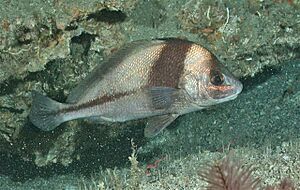Blackbar drum facts for kids
Quick facts for kids Blackbar drum |
|
|---|---|
 |
|
| Conservation status | |
| Scientific classification | |
| Synonyms | |
|
The blackbar drum (Pareques iwamotoi) is a type of ray-finned fish that lives in the ocean. It belongs to a group of fish called "drums" or "croakers." You can find this fish in the western part of the Atlantic Ocean.
Contents
Discovering the Blackbar Drum
Scientists first officially described the blackbar drum in 1988. Two American fish experts, George C. Miller and Loren P. Woods, gave it its scientific name. They found the first example of this fish off the coast of Pensacola, Florida, in the United States. It was found at a depth of about 101 meters (331 feet).
How the Blackbar Drum Got Its Name
The scientific name for the blackbar drum is Pareques iwamotoi. The second part of its name, iwamotoi, is a special tribute. It honors a scientist named Tomio Iwamoto. He was a good friend of Miller and Woods. Tomio Iwamoto also helped on the trip where they found the first blackbar drum.
What Does the Blackbar Drum Look Like?
The blackbar drum has a body shape that is quite deep and somewhat diamond-shaped. Its back is arched, and its head is low. It has fairly large eyes. The snout sticks out a bit over its mouth. The upper jaw has a small notch and covers the lower jaw.
This fish has rows of small, brush-like teeth. The teeth on the outside row of the lower jaw are larger. They look a bit like canine teeth. The blackbar drum does not have any whiskers (called barbels) on its chin. However, it does have five small pores there. It also has ten pores on its snout.
The dorsal fin, which is on its back, is quite long. It has a deep cut that divides it into two parts. The front part has 8 to 10 strong spines. The back part has one spine and 37 to 41 soft rays. The spiny part of the fin is tall. The anal fin, on its underside, has two spines and seven soft rays.
The blackbar drum's body is covered in rough scales. Its head has smoother scales. The bases of its soft dorsal and anal fins also have thick scales. This fish can grow up to 20 centimeters (about 8 inches) long.
Its main color is gray. It has a wide black bar that runs from its back fin down to its belly fin. There is also a thinner dark stripe that goes along its side. All of its fins are dark. Young blackbar drums are lighter in color. They have a thin black bar down the middle of their snout. Another black bar is found between their eyes. They also have the same body stripes as the adults. As they get older, these stripes become less clear.
Where the Blackbar Drum Lives
The blackbar drum lives in the western Atlantic Ocean. You can find it from North Carolina down into the Gulf of Mexico. However, it is not found near Cuba. It also lives along the Caribbean coast of Central and northern South America. This includes areas from southern Nicaragua to the Orinoco Delta in Venezuela.
These fish usually live in waters between 37 and 184 meters (121 to 604 feet) deep. Young fish, however, might be found in much shallower areas. In the Gulf of Mexico, they prefer shallow coastal waters. They live over sandy, muddy, or rocky bottoms.


